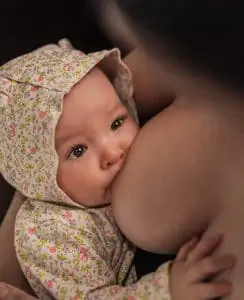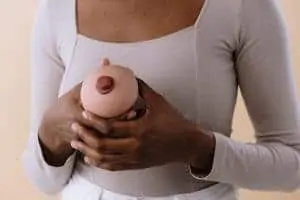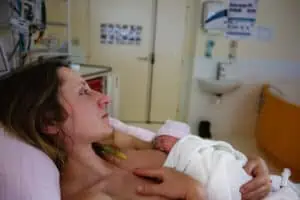Unlike bottle feeding, when you breastfeed your baby, it’s impossible to know how much milk he drinks each time. That means you might be left wondering how do I know my baby is full when breastfeeding?
Not using bottles is a benefit of breastfeeding. You don’t need to worry about washing bottles or measuring and mixing formula. It takes a load off of you, but it’s not an exact science, and when your baby cries without any apparent problem, you can’t be sure if he’s hungry or not.
Even though our breasts don’t have ounce indicators on the side to let us know how much our babies consume, babies have biological signs and reflexes that help you understand your child’s needs.
The Early Signs of Hunger
The first thing you need to know is the early signs of hunger. It’s always best to feed your babies before they are too hungry; a hungry baby will be angry and often inconsolable, making it harder to breastfeed.
Early signs of hunger include:
- Stirring
- Smacking Lips
- Sticking Out Tongue
These are the earliest signs; your baby might not be fussy at this stage. He might just be moving around a bit, sticking his tongue out, but seemingly happy at the time. It’s easy to miss these cues, and then your baby might present other signs, such as:
- Rooting Reflex
- Bringing Hand to Mouth
- Turning Head Toward Pressure
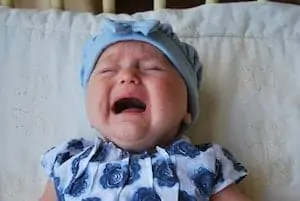
When your baby reaches this point, it means that he is hungry, and his innate behavior takes over. These are the behaviors that your baby practiced in the womb, natural movements, and reflexes that let you know your baby is ready to eat.
Remember that, while the later behaviors are more obvious, they mean that your baby is past the point of early hunger. Latching a hungry, angry baby is challenging; your baby might not latch properly at this point.
What Are The Signs Your Infant is Full?
A full baby looks full and content. It can be easy to identify when your baby is satisfied and happy after breastfeeding.
Take a close look at your baby. Does he look relaxed, content, and sleepy?
A few signs that your infant is full include:
Turning Away and Stops Nursing
When a baby is full, he might thrust the nipple out of his mouth with his tongue. He might turn his head away from the breast when he is full. If you try to push your baby to continue to nurse and he’s full, he might cry or shove away.
Distracted
When your baby is full and alert, he might decide he wants to play or become distracted. Instead of paying attention to nursing, he might think that the TV or his sibling is more interested than breastfeeding.
Starts to Fall Asleep
Do you know that relaxed, content feeling that you have after a big meal? Babies with a full stomach can easily drift off to sleep after breastfeeding. Your baby feels content and gratification when his belly is small, so he gets drowsy when he gets full.
Open Hands Not Fists
One of the telltale signs of your baby being full is relaxed, open hands with fingers extended. This is a classic indicator of being content. If your baby’s hands are bunched in a fist, chances are he is still hungry.
Relaxed, Loose Body
Take a look at your baby’s posture. If your baby looks relaxed and loose after a feeding, it typically means that he is full.
Wet Burp
Some babies will have wet burps after they’re full and done feeding. You might notice milk dribbling out of his mouth, which is a clear sign that he’s stuffed to the brim!
Hiccups
Some doctors think that hiccups are a sign that your baby’s stomach is too full. It often happens because a full stomach causes food and acid to come up.
When you pick up your baby’s arm, does it feel tense, or does it fall back in place relaxed? If it falls back into place, chances are your baby is full and content. If your baby wakes up when you move him and continues to eat her hands, then it means your baby is still hungry.
This is important:
Take a look at your breasts as well. You might notice that your breasts are empty and soft when your baby is done nursing. If your breasts are firm still, it might be an indicator that he needs to continue breastfeeding.
How Do I Know My Baby is Done Breastfeeding?
When you think your baby is done breastfeeding, you might wonder how to tell your baby is done and full.
You have to pay attention to your baby. Please take a look at his disposition. Is he relaxed and content? Look at his hands; are they in a fist or open? If you’re wondering if your baby is still hungry after breastfeeding, his behavior and body language can be the most telling.
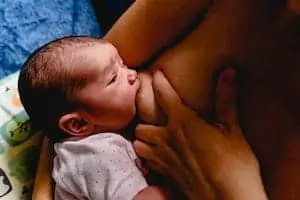
The great thing about breastfeeding is that you can always offer the breast again. If you are worried that your baby is not satisfied, offer your next breast because it’s ready and available.
Offering a second or “third” breast (that means you’re going back to the first breast you provided after your baby is done with the second) will let you know if your baby is done breastfeeding.
A hungry baby will take the breast, without a doubt, and continue to nurse at a steady pace. Your baby might take the breast and decide quickly he’s done and let go. That’s okay!
How Do I Know How Much Breast Milk My Baby is Getting?
Since you can’t see how much milk your baby drinks each time, it can be hard to know how much breast milk your baby receives. You can watch for these signs that let you know your child is well-fed.
Feeding Frequency
It’s best if your baby is fed eight to 12 times in 24 hours. After each feeding, your child should be content and full.
Comfortable Breastfeeding
A meaningful sign of good breastfeeding is that you’re comfortable and pain-free after each feeding. Your nipples should not be sore, cracked, broken, or bleeding.
Soft Breasts After Nursing
For some women, especially in the first few weeks of life, their breasts are never soft as their bodies adjust to creating a healthy supply. However, once your supply is established, your breasts will likely be soft and feel less full after a complete feeding.
Properly Shaped Nipples After Feedings
Take a look at your nipples after you finish feeding your baby. Your nipple should be the same shape after feeding as it looks before one. That means you don’t want to see your nipple looking white, misshapen, squashed, or anything odd. The only exception to this is having flat or inverted nipples; they’ll be more drawn out.
Enough Dirty Diapers

In the first week of life, your baby will have dirty diapers equivalent to their age. So, a three-day-old baby will have three dirty or wet diapers. Once your child is a week old, you want to see six to eight wet diapers each day.
Pooping schedules can be a bit different. Typically, if you see one to two poops per day, you can be assured that your child is eating enough. Some breastfed babies have fewer diapers than that; keep an eye and ask your doctor if you feel unsure.
Poop Color
By the time your baby is a week old, his poops should be a yellowy-mustard color. It takes several days to progress to this color as his bowels work out the meconium.
Audible Swallowing and Rhythmic Feedings
You should be able to hear your baby swallowing while he feeds. This is more likely when your baby is latched correctly, making it more likely for your baby to develop a rhythmic feeding. When you hear your baby swallowing and pausing, then starting again, it’s a good sign that your milk is in and your baby is comfortably breastfeeding.
Final Thoughts
Most importantly, looking at the signs your baby gives you rather than checking on a clock will let you know if your baby is full. Don’t set a time limit on breastfeeding or stop breastfeeding when the clock says it’s time. Your baby has biological cues designed to let their parents know they’re hungry. Follow those cues, and you’ll always know when your baby is full after breastfeeding.
Hey, this is Linda. My biggest accomplishment in life is being a mother of four children. Their current ages range from almost ten years old down to 20 months old.
I’m passionate about writing parenting articles because I understand so well all of the problems and trials you face as a parent. From breastfeeding woes to budgeting problems and behavior problems, along with everything in between, chances are I’ve faced it over the last ten years. Read more about Linda here.


